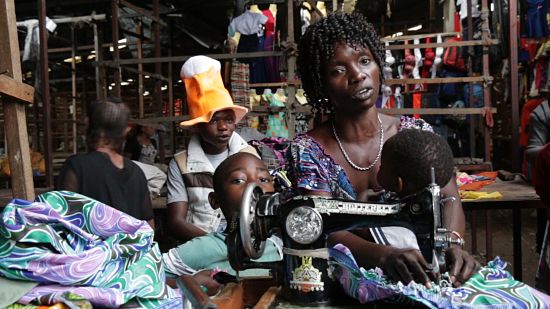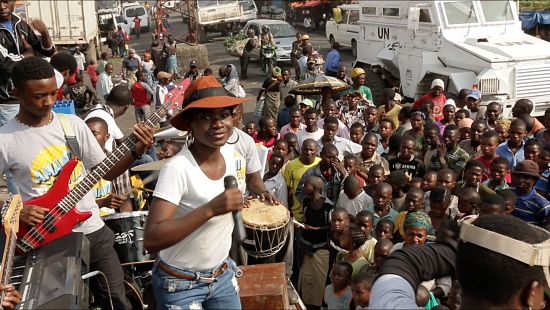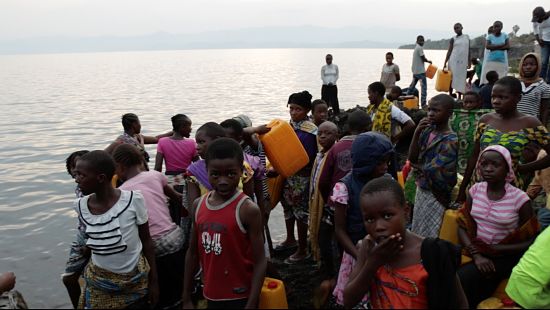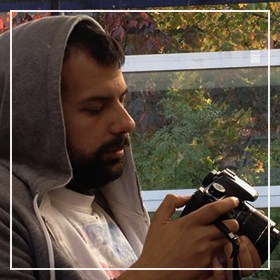This paper presents a collaborative approach to making music video clips as an ethnographic research tool. The case study is a one-month fieldwork trip in Goma, the Democratic Republic of the Congo, conducted between February and March 2015 with fellow filmmakers Paloma Yañez Serrano and Benjamin Llorens Rocamora.[1] More specifically, the present work analyses the experience of a collaborative music video clip realised together with a group of young Congolese musicians.
Although collaborative music video clips have been included in various ethnographic films such as Fabrik Funk and Golden Scars by Alexandrine Boudreault-Fournier and Shooting Freetown by Kieran Hanson, there is very little academic literature on this experimental research method (Boudreault-Fournier 2010, Ranocchiari 2015)[2]. This paper intends to contribute to the inclusion of collaborative music video making within the academic debate, following up on the panel ‘Music Video Clips as Participatory Research Tool in Ethnomusicology’ presented at the second AIBR International Conference of Anthropology in Barcelona, Spain, on 9 September 2016.[3] The reasons for this are in epistemological, ethical, and political reflections concerning the fieldwork, as I discuss below.
When the music matches up with the images
The methodology of collaborative filmmaking within audiovisual ethnography was born with Rouch’s ciné-trance, achieving through the camera the principle of a shared anthropology between the observant and the observed. Ethnofiction is a participatory genre where the subjects/actors improvise fictional actions in front of the camera, inspired by their own lived experiences (Sjöberg 2006a). Collaborative music video clips can be considered as an application of ethnofiction to ethnomusicological film (Ranocchiari 2015: 233-234).
We do not necessarily have to consider music video clip in its standard commercial shape —two to three minutes long, fast-paced, with jump cuts— although this format can be applied when useful.
What is important is to elaborate together with the musicians a creative dialogue between images and sounds, in a format —the video clip— that constitutes a global vocabulary of popular music, which process touches all the steps of the musical ecology, from the conception and production of the piece to its dissemination.

Music video clips are non-human actors with a strong impact on musicking (Steingo 2015: 120). Digital music media are ‘reshaping overlapping national and global imaginaries and the changing nature of cosmopolitanism’ (Shipley 2013: 363). This is particularly outstanding in transnational societies marked by large emigration such as the Congolese (White 2012: 728-729) where music circulation between homeland and diaspora is widely digitised, and video clips convey important aesthetic values and visual components of the cultural production. Such a circuit contributes to the creation of ‘cosmopolitan styles that transcend local-global oppositions’ promoting instead a sense of ‘worldliness’ (Shipley ibid: 368). Particularly in the case of hip-hop and all the other genres generally labelled under the umbrella term of ‘urban music’, the visual code spread by videos – gestures, attitudes, way of dressing, urban scenarios – is an unavoidable aspect of this global community, which corresponds to the claim for modernity, rebellion and self expression by larges masses of African youth (Charry 2012).
Besides, the recourse to video clip allows the diasporic artists to shape their art message to target Congolese audience, at the same time that enables the Congolese musicians to make their tunes circulating abroad, in the hope of capturing the attention of Euro-American sponsors and media.
Although only an elite group of wealthy Congolese citizens have access to the Internet on a daily – or even weekly – basis, video clips remain relevant for the national market, as TV is one of the main media responsible for spreading music trends and crazes, through programmes and channels dedicated to Congolese music transmitted on a continental scale.
On a local level, the hand-to-hand circulation of digital music files – via devices like USB flash drivers, cellphones and MP3 players – allows audiovisual files to be disseminated through the network of music market and media and to reach the public, even if offline.
Video clips as a research method
The video clip inspires a hermeneutic attitude that decentralises text and textuality and opens up to non-discursive forms, which are the natural means of expression for billions of human beings, illiterate, marginalised, or oppressed, who ‘do not have the privilege of explicitness’ (Conquergood 2002: 148). The non-narrative structure of the video clip, ‘a hybrid between an advertising vehicle and postmodern video art’ (Wollen 1986: 169) is appropriate to express non-verbal imagination and aesthetics of the musicians, and stimulates the use of body language and dance as organic codes within a particular musical language.
The intertextual nature of video clip as a film process places the present research in dialogue with an articulation of musical meanings wider than the mere sonic artefact.

Collaborating with musicians through the video clip turns fieldwork into a mutually beneficial project, in which all subjects involved in the ethnographic encounter can take part in while pursuing their own interests. The making of the video clip gives a deep insight of the economic and social circuits where the work of the musician participants is located, integrating the researcher in a more intimate sphere, both human and professional (Ranocchiari 2015: 229).
By involving the artists in the realisation of the visual texts that will support their tunes, we seek an integrated approach to the ecology of transnational Congolese popular music, including musical creation, sense-making through music, political impact, social positioning, economic networks, strategies of diffusion, dialogue with the audience, musicians’ dreams and desires.
As in other collaborative film techniques, the filmmaker has to share the authority and relinquish part of the control on the process in order to leave room for the musicians’ creativity.
Collaborative music video making in Goma
During our fieldwork in Goma, the methodology of participatory video clip allowed us a great deal of access to the life spaces and histories of the musicians, who were enthusiastic about taking part in a documentary film, and excited about collaborating in the realization of their music video clip – the first one, for some of them. On several occasions, we were exhorted to take the camera out and film in private domestic reunions, in spite of my worries. The medium of the ‘moving image’ softens the boundaries and highlights the opportunities ‘that can arise when one culture observes another very different’ (Wissler 2009: 45-47). The lens mediated the process of sense-making we went through while observing, and being observed.
The camera was the contact tool, in a context where white people are unlikely to be seen walking on the streets or engaging with locals in public spaces, hence every normal interaction implied in doing ethnography – and, even more, the collaborative approach we were adopting – was welcome as surprisingly, pleasantly bizarre.
The huge imbalance of power between us investigators and the average population of Goma is implicitly present in every image we have taken. However, the audiovisual collaboration has allowed the narrative structure of the subjects of research to overlap ours, giving life to an extremely intense field experience.
Almost all the artists we knew live in shacks without running water or electric power, and music does not provide them with any source of stable income. Nonetheless, they dedicate all their energies to their music, which they perceive as a mission. Bob White (2010: 744) states that Congolese popular music ‘has never done a systematic criticism of power’. To the contrary,
the musicians we engaged with in Goma defines what they play as ‘la musique de la révolution’, which consists in clamouring for the social changes they need: no more war, massacres, corruption; free education; less social inequality; and an to the exploitation of Congolese wealth.
The specificity of Goma music scene is predicated on thirty years of bloodthirsty civil war in the Kivu region. The war attracted countless multinational NGOs to face a constant humanitarian emergency. NGOs and programmes like UNICEF play a crucial role in local cultural production, promoting music events to support their agenda. In a context where there is virtually no private music market, the possibility to find a sponsor influences the shape of the musical message, pushing the artists to adhere to the rhetoric of European and North American NGOs.

Although many local musicians consider themselves ‘conscious’ artists, many video clips realised in Goma represents the singers as wealthy and stylish urban hustlers – i. e. Yoka by M’Chriss feat. M’yomba; Beautiful Forever by M’Chriss feat. Will’Stone; Unapedeza by Mista Faba. As there is no room for these images in real public space in Goma, marked by extreme poverty, usually videos are shot in hotels: semi-interiors (gardens, swimming pool or terraces), interiors (confortable rooms, night clubs) or close-ups of fancy cars passing by the few kilometres of paved road that link Goma city centre to the Rwandan border.
Will’Stone, Voldie Mapenzi, Mista Faba, and Black Man Bausi, the four artists who took part in our project, selected a song called Amani Kila Siku (kiSwahili for ‘peace every day’) that features the four of them for the shooting of the video clip. The lyrics express the need of local people, specially the youth, to overcome the endless conflict that afflicts the region. We proposed them to shoot the video outdoors and to involve the people in the streets in the filming.
The artists accepted this, welcoming the challenge of something new to them, and appropriating it to their message; so they led us through the branches of their semiotic networks, pointing our camera to the most significant scenarios for expressing their message.
Their agency has shaped the political sense of the images, that is, the aesthetics of the video, without any explicit narrative apart from sounds and words of their music.
Urban space encodes all of that; in our walking with the camera, the streets were eliciting most of the content of the film: a line of children carrying water into bins introduced the issue of the privatization of Lake Kivu resources. Buildings ruined by the last lava flow gave the artists a perfect scenario to enact the main concern of their music production: war. The lyrics of their song are a continuous claim for peace.
By selecting the semi-space of a tumbledown edifice to shoot a part of the video clip, musicians have been able to show war through place, evocating the massive bombing during the battle of Goma in 2013, and locating their clamouring for social changes in an appropriate setting.

The tension between our ethnographic approach to filming, and the aesthetic video tailoring that musicians are used to in Goma, swiftly emerged after the editing of the clip. Will’Stone, one of the rappers featuring in Amani Kila Siku, gently observed that a strip of his undershirt appears at several points in the video clip; however, he did not ask us to remove these clips. A few days after we released the video online, Will’Stone commented on Amani Kila Siku Facebook page:
I really love this film because there is no editing, just a real reality.
Conflict resolved.
Hanging out with the musicians, following their pathways, being welcomed to their networks led us to expand the communication with them. They brought us into their kaleidoscopic routine, walking miles, as the waves of communication in Goma are physical rather than virtual, and interactions are mainly face-to-face. Amani Kila Siku was played in a loop, continuously, as they bring their music everywhere with them: on a USB stick, to try to convince radio speakers, journalist and venues DJs to play their songs; on a portable stereo, to play on the way, everywhere they go, until the battery dies.
The film process involved several friends and acquaintances who actively participated in the process, choreographing, suggesting solutions, chatting with us between takes. Plus, the shooting sessions elicited interesting pieces of public discourse, putting street vendors and moto-taxi drivers in dialogue with the artists about the role of music face to the harsh living conditions of the region.
Such an intense adherence to the musicians’ personal point of view has inevitably restricted the spectrum of our observations, limiting our capability to critically elaborate the inputs from the fieldwork. The result of our research is inevitably guided by them, as is our whole gaze on Goma. At a personal level, that is achievement enough.
[1] The fieldwork project focused on shooting the material for a documentary film about the everyday life of four local singers selected for the second edition of the Festival Amani, an annual international music event held in Goma. This film, called Amani Kila Siku, is still in production.
[2] Both Alexandrine Boudreault-Fournier and Dario Ranocchiari are ethnographic filmmakers who have included music videos in their researches; that means, virtually no attention has been given to collaborative music video clip inside academia apart from scholars who are practitioners of video clips themselves.
[3] The panel, co-chaired by Dario Ranocchiari and I, included papers presented by Kieran Hanson (the University of Manchester) and Yushi Yanohara (Kyoto University).
Videography
Amani Kila Siku by Voldie Mapenzi, Mista Faba, Will’Stone, Black Man Bausi
Yoka by M’Chriss feat. M’yomba
Unapedeza by Mista Faba
Beautiful Forever by M’Chriss feat. Will’Stone
References
Boudreault-Fournier, A. (2010). Complicity Through Montage: A Call For An Intercultural Approach To Ethnographic Filmaking, Ethnologies. Vol. 31, 2, 169-188.
Charry E. (ed. 2012). Hip Hop Africa. New African Music in a Globalizing World. Bloomington, Indiana University Press.
Conquergood, D. (2002). Performance Studies: Interventions and Radical Researc. The MIT Press. Vol. 46, 2, 145-156.
Ranocchiari, D. (2015). Creole: Inside. Cómo hacer filmaciones no etnográficas puede servir a la realización de una etnografía. Revista de Antropología Experimental Vol. 15, 225-239.
Shipley, J. W. (2013). Transnational Circulation and Digital Fatigue in Ghana’s Azonto Dance Craze. American Ethnologist. Vol. 40, 2, 362-381.
Sjöberg, J. (2006a). The Ethnofiction in Theory and Practice Part 1. NAFA Network. Ed. 13, 3 (August).
Sjöberg, J. (2006b). The Ethnofiction in Theory and Practice Part II. NAFA Network. Ed. 13, 4 (December).
Steingo, G. (2015). Sound and Circulation: Immobility and Obduracy in South African Electronic Music. Ethnomusicological Forum. Vol. 24, 1, 102-123.
White, B. W. (2012). Pour l’amour du pays: genres et générations dans les clips vidéo à Kinshasa, R.D. Congo. In Muriel Gomez-Perez and Marie-Nathalie Leblanc, eds. L’Afrique des générations : entre tensions et négotiations. Paris, Karthala, 711-764.
Wissler, H. (2009). Grief-Singing and the Camera: The Challenges and Ethics of Documentary Production in an Indigenous Andean Community. Ethnomusicological Forum. Vol. 18, 1, 37-53.
Wollen, P. (1986). Ways of thinking about music video (and post-modernism). Critical Quarterly. Vol. 28, 1 & 2, 167-170.






I LOVE IT